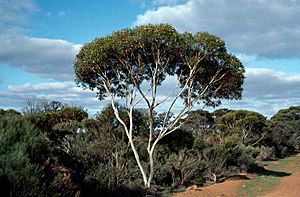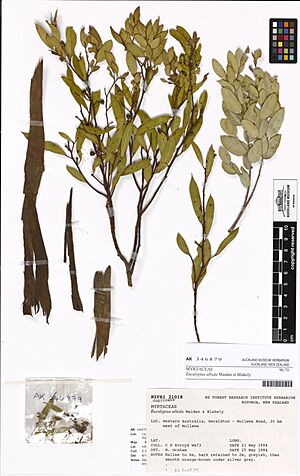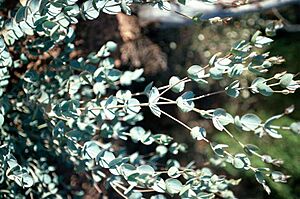White-leaved mallee facts for kids
Quick facts for kids White-leaved mallee |
|
|---|---|
 |
|
| Eucalyptus albida at Lake Grace | |
| Scientific classification | |
| Genus: |
Eucalyptus
|
| Species: |
albida
|
The Eucalyptus albida, also known as the white-leaved mallee, is a special type of tree or shrub. It's called a mallee because it has many stems growing from a large, woody base underground. This plant is endemic, meaning it only grows naturally in one place: the south-west part of Western Australia.
The white-leaved mallee has smooth bark that can be white or greyish-brown. Its adult leaves are shaped like a spear, and its flowers are creamy white. These flowers grow in small groups. After the flowers, it produces fruits that look like half-spheres or cones. Young leaves on this plant are often kept even as it gets older. These young leaves grow in pairs, are egg-shaped or heart-shaped, and have a pretty bluish-grey color.
Contents
What Does the White-Leaved Mallee Look Like?
The Eucalyptus albida is a mallee, which means it's a type of eucalypt that usually grows as a shrub with multiple stems. It can reach a height of about 1.5 to 4 meters (5 to 13 feet). Its bark is smooth and can be white or a greyish-brown color.
Leaves of the White-Leaved Mallee
Young plants have leaves that grow in opposite pairs. These leaves are egg-shaped or heart-shaped and are a bluish-grey color on both sides. They are about 15 to 40 millimeters (0.6 to 1.6 inches) long and 13 to 35 millimeters (0.5 to 1.4 inches) wide. It's common to see these young leaves even on older plants.
The adult leaves are different. They are shaped like a spear (lance-shaped) and are a shiny dark green on both sides. These adult leaves are typically 40 to 70 millimeters (1.6 to 2.8 inches) long and 5 to 15 millimeters (0.2 to 0.6 inches) wide.
Flowers and Fruits of the White-Leaved Mallee
The flower buds of the white-leaved mallee grow on a branching stem. Each branch holds groups of seven to eleven buds. These groups are on a small stalk called a peduncle, which is about 5 to 15 millimeters (0.2 to 0.6 inches) long. Each individual bud sits on an even smaller stalk called a pedicel, about 3 to 6 millimeters (0.1 to 0.2 inches) long.
The buds are shaped like a spindle, which is narrow in the middle and wider at the ends. They have a cone-shaped cap called an operculum, which is about 3 to 4 millimeters (0.1 to 0.2 inches) long. This cap is about the same length as the base of the flower, called the floral cup. The flowers themselves are a creamy white color.
The white-leaved mallee usually flowers between November and January. After flowering, it produces fruits that are shaped like a half-sphere or a cone. These fruits are about 4 to 5 millimeters (0.16 to 0.20 inches) long and wide.
How Was the White-Leaved Mallee Named?
The Eucalyptus albida was officially described for the first time in 1925. Two botanists, Joseph Maiden and William Blakely, gave it its scientific name. They published their description in a scientific journal called Journal and Proceedings of the Royal Society of New South Wales.
The first sample of this plant used for its description was collected near Harrismith by another botanist named Charles Gardner. The second part of its scientific name, albida, comes from the Latin word albidus. This word means "whitish," and it refers to the bluish-grey color of the plant's young leaves.
Where Does the White-Leaved Mallee Grow?
The white-leaved mallee grows in sandy soil, often mixed with gravel, and over a type of soil called laterite. It is found in areas with kwongan (a type of shrubland) and other shrubland environments.
You can find this plant from places like Tammin and Narrogin in the west, stretching east to Hyden and Ravensthorpe. There's also a separate group of these plants growing near Badgingarra, which is called a disjunct population.
Is the White-Leaved Mallee Protected?
The Western Australian Government's Department of Parks and Wildlife has looked at the Eucalyptus albida. They have classified it as "not threatened," which means it is not currently at risk of disappearing.
What Are the Uses of the White-Leaved Mallee?
The young leaves or new growth (called coppice regrowth) from this plant are used by florists. Florists use them as a "filler" in dried flower arrangements. They often call this plant "rustle gum."
This plant is also good for growing in gardens because it can handle dry conditions and cold temperatures (frost).




